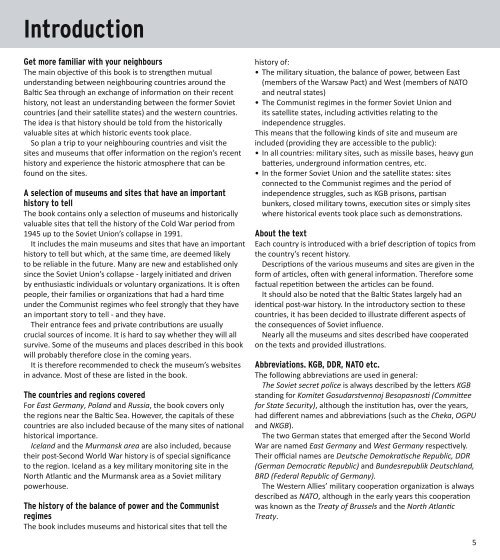You also want an ePaper? Increase the reach of your titles
YUMPU automatically turns print PDFs into web optimized ePapers that Google loves.
Introduction<br />
Get more familiar with your neighbours<br />
The main objecti ve of this book is to strengthen mutual<br />
understanding between neighbouring countries around the<br />
Balti c Sea through an exchange of informati on on their recent<br />
history, not least an understanding between the former Soviet<br />
countries (and their satellite states) and the western countries.<br />
The idea is that history should be told from the historically<br />
valuable <strong>sites</strong> at which historic events took place.<br />
So plan a trip to your neighbouring countries and visit the<br />
<strong>sites</strong> and museums that off er informati on on the region’s recent<br />
history and experience the historic atmosphere that can be<br />
found on the <strong>sites</strong>.<br />
A selection of museums and <strong>sites</strong> that have an important<br />
history to tell<br />
The book contains only a selecti on of museums and historically<br />
valuable <strong>sites</strong> that tell the history of the <strong>Cold</strong> War period from<br />
1945 up to the Soviet Union’s collapse in 1991.<br />
It includes the main museums and <strong>sites</strong> that have an important<br />
history to tell but which, at the same ti me, are deemed likely<br />
to be reliable in the future. Many are new and established only<br />
since the Soviet Union’s collapse - largely initi ated and driven<br />
by enthusiasti c individuals or voluntary organizati ons. It is oft en<br />
people, their families or organizati ons that had a hard ti me<br />
under the Communist regimes who feel strongly that they have<br />
an important story to tell - and they have.<br />
Their entrance fees and private contributi ons are usually<br />
crucial sources of income. It is hard to say whether they will all<br />
survive. Some of the museums and places described in this book<br />
will probably therefore close in the coming years.<br />
It is therefore recommended to check the museum’s web<strong>sites</strong><br />
in advance. Most of these are listed in the book.<br />
The countries and regions covered<br />
For East Germany, Poland and Russia, the book covers only<br />
the regions near the Balti c Sea. However, the capitals of these<br />
countries are also included because of the many <strong>sites</strong> of nati onal<br />
historical importance.<br />
Iceland and the Murmansk area are also included, because<br />
their post-Second World War history is of special signifi cance<br />
to the region. Iceland as a key military monitoring site in the<br />
North Atlanti c and the Murmansk area as a Soviet military<br />
powerhouse.<br />
The history of the balance of power and the Communist<br />
regimes<br />
The book includes museums and historical <strong>sites</strong> that tell the<br />
history of:<br />
• The military situati on, the balance of power, between East<br />
(members of the Warsaw Pact) and West (members of NATO<br />
and neutral states)<br />
• The Communist regimes in the former Soviet Union and<br />
its satellite states, including acti viti es relati ng to the<br />
independence struggles.<br />
This means that the following kinds of site and museum are<br />
included (providing they are accessible to the public):<br />
• In all countries: military <strong>sites</strong>, such as missile bases, heavy gun<br />
batt eries, underground informati on centres, etc.<br />
• In the former Soviet Union and the satellite states: <strong>sites</strong><br />
connected to the Communist regimes and the period of<br />
independence struggles, such as KGB prisons, parti san<br />
bunkers, closed military towns, executi on <strong>sites</strong> or simply <strong>sites</strong><br />
where historical events took place such as demonstrati ons.<br />
About the text<br />
Each country is introduced with a brief descripti on of topics from<br />
the country’s recent history.<br />
Descripti ons of the various museums and <strong>sites</strong> are given in the<br />
form of arti cles, oft en with general informati on. Therefore some<br />
factual repeti ti on between the arti cles can be found.<br />
It should also be noted that the Balti c States largely had an<br />
identi cal post-<strong>war</strong> history. In the introductory secti on to these<br />
countries, it has been decided to illustrate diff erent aspects of<br />
the consequences of Soviet infl uence.<br />
Nearly all the museums and <strong>sites</strong> described have cooperated<br />
on the texts and provided illustrati ons.<br />
Abbreviations. KGB, DDR, NATO etc.<br />
The following abbreviati ons are used in general:<br />
The Soviet secret police is always described by the lett ers KGB<br />
standing for Komitet Gosudarstvennoj Besopasnosti (Committ ee<br />
for State Security), although the insti tuti on has, over the years,<br />
had diff erent names and abbreviati ons (such as the Cheka, OGPU<br />
and NKGB).<br />
The two German states that emerged aft er the Second World<br />
War are named East Germany and West Germany respecti vely.<br />
Their offi cial names are Deutsche Demokrati sche Republic, DDR<br />
(German Democrati c Republic) and Bundesrepublik Deutschland,<br />
BRD (Federal Republic of Germany).<br />
The Western Allies’ military cooperati on organizati on is always<br />
described as NATO, although in the early years this cooperati on<br />
was known as the Treaty of Brussels and the North Atlanti c<br />
Treaty.<br />
5


